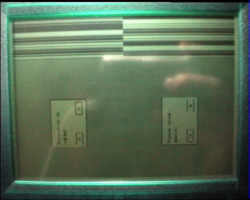|
 Well, what would the life of a real Newton fan who is said to have marginal
hardware knowledge be without the occasional challenge. If this board couldn’t be persuaded to power up a Newton, maybe it would be more accommodating
when plugged into an eMate. Which is exactly what I did, with the result shown in the picture. Well, what would the life of a real Newton fan who is said to have marginal
hardware knowledge be without the occasional challenge. If this board couldn’t be persuaded to power up a Newton, maybe it would be more accommodating
when plugged into an eMate. Which is exactly what I did, with the result shown in the picture.
What we see here looks suspiciously like the first of the two warnings one gets after a hard reset, rotated 90°.
I can "tap" both buttons, but this requires placing the stylus nowhere near where the buttons actually are. I discovered this by drawing horizontal and vertical
lines in a grid-like pattern until the buttons reacted. The buttons in both message boxes are highlighted simultaneously, which is not surprising because they only
look like two message boxes, but are in fact only one.
If I tap the bottom button (which is probably the "OK" button), two new message boxes appear that strongly resemble the
well-known second warning one encounters during a hard reset. Tapping "OK" again restarts the eMate, which then
shows the first message again. No matter what and in what order I tap, the eMate always get back to this message, it never finishes booting the operating system.
Both the image and the behavior allow some conclusions, though. Obviously enough of the operating system is loaded to
allow the eMate to sense and react to pen input. The display works, at least kind of, which also requires a fair amount of the operating system to be loaded.
Time to do some thinking. Hmmm...
Why did this board come up in an eMate, but not in a normal 2000? The fact that the 2000’s code name is printed on it
suggests that it was intended for this model, and there is a lot of further evidence. Since the screen content is rotated 90°
on an eMate, wich always powers up in landscape mode after a hard reset, this ROM board must have been developed for a device that, like the 2000, powers up in portrait mode.
The eMate does not react to the keyboard. Not surprising if the ROM board was designed for a keyboard-less machine like
the 2000. Neither does it chime after the hard reset, which would also make sense for a board that wasn’t to be used in an
eMate (whose volume is controlled by a a mechanical slider), but in a device with software volume control like the 2000.
A possible explanation is that the 2000’s original design used the same RISC CPU as the eMate: The ARM710. Later the 2000 was redesigned for the SA-110 CPU
. This assumption is backed up by what Mike Culbert, a former Newton hardware developer, once said in an interview:
“The MessagePad 2000 design was already under way using an ARM710 microprocessor. However, once we had StrongARM silicon in hand, it became clear it was a viable alternative."
In conclusion it seems likely that my weird ROM board came from an early (note the (C) 1995 date on the board) EVT
prototype of the Newton MessagePad 2000. A prototype that had a motherboard based on the ARM710 CPU. It seems also likely that this prototype had a screen resolution different from the 2000’s
320 x 480 pixels. As there are two message boxes where there should be only one, with almost identical display content in both halves of the screen, it can be assumed
that the operating system in this ROM board expects half the horizontal screen resolution of an eMate. This would be 240 x 320
pixels, which happens to be the screen resolution of the Newton 110, 120 and 130 models.
This would also explain why the screen content looks somewhat blurred. Maybe lines 1, 3, 5... are used for the left and
lines 2, 4, 6... are used for the right half.
But who knows. Maybe it's not a resolution problem at all, but the mere fact that the display control electronics of the
eMate is not being correctly initialized by the ROM.
I would gladly try out some some other experiments with this board, but I am currently at a loss as to which kind of
experiments this could be. If you have an idea what I could try, please let me know.
|

